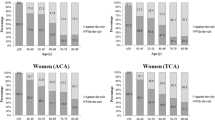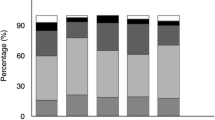Abstract
Purpose
To assess the longitudinal change in components of astigmatism from age 4 to 7 years and its association with axial length-corneal radius ratio (AL/CR).
Methods
Children born between September 2011 and August 2012 in Yuhuatai District of Nanjing were invited to participate in the Nanjing Eye Study for a comprehensive eye examination annually since 2015. The data presented in this paper were obtained in 2016, 2017, and 2019. At each study encounter, noncycloplegic autorefraction and ocular biometric parameters were measured. Changes of total astigmatism (TA), corneal astigmatism (CA), anterior corneal astigmatism (ACA), residual astigmatism (RA), and internal astigmatism (IA) were analyzed in clinical notation (Cyl) and vector notation (J0, J45).
Results
Nine hundred fifty-four children (mean ± standard deviation of baseline age: 4.63 ± 0.29 years, 53.7% boys) had complete data and were included in this study. Mean slopes of longitudinal changes in Cyl notation were significantly negative for TA, CA, and ACA, but positive for IA. TA, CA, ACA, and RA of J0 notation had a shift toward increasing with-the-rule (WTR) astigmatism and/or decreasing against-the-rule (ATR) astigmatism. TA of J45 notation showed an increase in astigmatism at axis 135° and/or a decrease in astigmatism at axis 45°, while CA and ACA of J45 notation showed an opposite change. Longitudinal changes in ACA and IA were negatively correlated in J0 notation, but not in J45 notation. Based on compensation factor (CF, defined as the minus ratio of IA and ACA), the compensation proportions for J0 in varying degrees (CF: 0.1–2) in 2016, 2017, and 2019 were 91.3%, 93.5%, and 90.0%, respectively, while these for J45 were 74.9%, 76.5%, and 34.6%, respectively. Higher AL/CR increase was associated with less decrease or more increase in CA and ACA of Cyl notation, and a shift toward increasing WTR and/or decreasing ATR in these of J0 notation.
Conclusions
The compensatory role of IA was persistent and prominent from 4 to 7 years old for J0 notation in Chinese young children. The progression of AL/CR was correlated with astigmatism originated from the cornea.


Similar content being viewed by others
References
Fan Q, Zhou X, Khor CC, Cheng CY, Goh LK, Sim X, Tay WT, Li YJ, Ong RT, Suo C, Cornes B, Ikram MK, Chia KS, Seielstad M, Liu J, Vithana E, Young TL, Tai ES, Wong TY, Aung T, Teo YY, Saw SM (2011) Genome-wide meta-analysis of five Asian cohorts identifies PDGFRA as a susceptibility locus for corneal astigmatism. PLoS Genet 7(12):e1002402. https://doi.org/10.1371/journal.pgen.1002402
Dobson V, Miller JM, Clifford-Donaldson CE, Harvey EM (2008) Associations between anisometropia, amblyopia, and reduced stereoacuity in a school-aged population with a high prevalence of astigmatism. Invest Ophthalmol Vis Sci 49(10):4427–4436. https://doi.org/10.1167/iovs.08-1985
Harvey EM (2009) Development and treatment of astigmatism-related amblyopia. Optom Vis Sci 86(6):634–639. https://doi.org/10.1097/OPX.0b013e3181a6165f
Huynh SC, Kifley A, Rose KA, Morgan I, Heller GZ, Mitchell P (2006) Astigmatism and its components in 6-year-old children. Invest Ophthalmol Vis Sci 47(1):55–64. https://doi.org/10.1167/iovs.05-0182
Wang Z, Huang D, Chen X, Zhu H, Sun Q, Wang Y, Zhang X, Wang Y, Zhai L, Wang C, Liu H (2019) Preschool children exhibit evident compensatory role of internal astigmatism in distribution of astigmatism: the Nanjing Eye Study. Invest Ophthalmol Vis Sci 60(1):73–81. https://doi.org/10.1167/iovs.18-24799
Harvey EM, Miller JM, Twelker JD, Sherrill DL (2014) Longitudinal change and stability of refractive, keratometric, and internal astigmatism in childhood. Invest Ophthalmol Vis Sci 56(1):190–198. https://doi.org/10.1167/iovs.14-13898
Harvey EM, Dobson V, Clifford-Donaldson CE, Green TK, Messer DH, Miller JM (2010) Prevalence of astigmatism in Native American infants and children. Optom Vis Sci 87(6):400–405. https://doi.org/10.1097/OPX.0b013e3181d95b23
Gwiazda J, Grice K, Held R, McLellan J, Thorn F (2000) Astigmatism and the development of myopia in children. Vision Res 40(8):1019–1026. https://doi.org/10.1016/s0042-6989(99)00237-0
Twelker JD, Miller JM, Sherrill DL, Harvey EM (2013) Astigmatism and myopia in Tohono O’odham Native American children. Optom Vis Sci 90(11):1267–1273. https://doi.org/10.1097/OPX.0000000000000065
Hashemi H, Fotouhi A, Yekta A, Pakzad R, Ostadimoghaddam H, Khabazkhoob M (2018) Global and regional estimates of prevalence of refractive errors: systematic review and meta-analysis. J Curr Ophthalmol 30(1):3–22. https://doi.org/10.1016/j.joco.2017.08.009
Rudnicka AR, Kapetanakis VV, Wathern AK, Logan NS, Gilmartin B, Whincup PH, Cook DG, Owen CG (2016) Global variations and time trends in the prevalence of childhood myopia, a systematic review and quantitative meta-analysis: implications for aetiology and early prevention. Br J Ophthalmol 100(7):882–890. https://doi.org/10.1136/bjophthalmol-2015-307724
Huang D, Zhang X, Wang Y, Zhu H, Ding H, Bai J, Chen J, Fu Z, Wang Z, Chen X, Liu H (2017) Pupillary measurements and anisocoria in Chinese preschoolers 3–4 years of age screened using the plusoptiX A12C. J AAPOS 21(4):262.e261-262.e265. https://doi.org/10.1016/j.jaapos.2017.04.011
Zhu H, Huang D, Sun Q, Ding H, Bai J, Chen J, Chen X, Wang Y, Zhang X, Wang J, Li X, Liu H (2017) Normative visual acuity in Chinese preschoolers aged 36 to <48 months as measured with the linear HOTV chart: the Yuhuatai Pediatric Eye Disease Study. BMJ Open 7(7):e014866. https://doi.org/10.1136/bmjopen-2016-014866
Huang D, Chen X, Zhu H, Ding H, Bai J, Chen J, Fu Z, Pan CW, Liu H (2018) Prevalence of amblyopia and its association with refraction in Chinese preschool children aged 36–48 months. Br J Ophthalmol 102(6):767–771. https://doi.org/10.1136/bjophthalmol-2016-310083
Wang Z, Tong H, Hao Q, Chen X, Zhu H, Huang D, Li R, Hu Z, Liu H (2020) Risk factors for astigmatic components and internal compensation: the Nanjing Eye Study. Eye (Lond). https://doi.org/10.1038/s41433-020-0881-5
Zhao X, Li R, Huang D, Tong H, Zhu H, Wang Y, Zhang X, Hao Q, Sun Q, Liu H (2020) Decreased retinal thickness in preschool offspring of maternal gestational hypertension: the Nanjing Eye Study. Acta Ophthalmol 98(6):e674–e679. https://doi.org/10.1111/aos.14351
Shankar S, Bobier WR (2004) Corneal and lenticular components of total astigmatism in a preschool sample. Optom Vis Sci 81(7):536–542. https://doi.org/10.1097/00006324-200407000-00015
Thibos LN, Wheeler W, Horner D (1997) Power vectors: an application of Fourier analysis to the description and statistical analysis of refractive error. Optom Vis Sci 74(6):367–375. https://doi.org/10.1097/00006324-199706000-00019
Muftuoglu O, Erdem U (2008) Evaluation of internal refraction with the optical path difference scan. Ophthalmology 115(1):57–66. https://doi.org/10.1016/j.ophtha.2007.02.022
Park CY, Oh JH, Chuck RS (2013) Predicting ocular residual astigmatism using corneal and refractive parameters: a myopic eye study. Curr Eye Res 38(8):851–861. https://doi.org/10.3109/02713683.2013.790976
Liu Y, Cheng Y, Zhang Y, Zhang L, Zhao M, Wang K (2017) Evaluating internal and ocular residual astigmatism in Chinese myopic children. Jpn J Ophthalmol 61(6):494–504. https://doi.org/10.1007/s10384-017-0532-y
Fan DSP (2004) Astigmatism in Chinese preschool children: prevalence, change, and effect on refractive development. Br J Ophthalmol 88(7):938–941. https://doi.org/10.1136/bjo.2003.030338
Tong L, Saw SM, Lin Y, Chia KS, Koh D, Tan D (2004) Incidence and progression of astigmatism in Singaporean children. Invest Ophthalmol Vis Sci 45(11):3914–3918. https://doi.org/10.1167/iovs.04-0492
He X, Zou H, Lu L, Zhao R, Zhao H, Li Q, Zhu J (2015) Axial length/corneal radius ratio: association with refractive state and role on myopia detection combined with visual acuity in Chinese schoolchildren. PLoS ONE 10(2):e0111766. https://doi.org/10.1371/journal.pone.0111766
Foo VH, Verkicharla PK, Ikram MK, Chua SY, Cai S, Tan CS, Chong YS, Kwek K, Gluckman P, Wong TY, Ngo C, Saw SM, On Behalf Of The Gusto Study G (2016) Axial length/corneal radius of curvature ratio and myopia in 3-year-old children. Transl Vis Sci Technol 5(1):5. https://doi.org/10.1167/tvst.5.1.5
Wang F, Xiao L, Meng X, Wang L, Wang D (2018) Development of corneal astigmatism (CA) according to axial length/corneal radius (AL/CR) ratio in a one-year follow-up of children in Beijing China. J Ophthalmol 2018:4209236. https://doi.org/10.1155/2018/4209236
Acknowledgements
We thank the children, their parents or legal guardians, and all the members of the Maternal and Child Healthcare Hospital of Yuhuatai District, Nanjing, China, for their helpful advice and support.
Funding
This work was supported by the National Natural Science Foundation of China (Grant No. 81673198; No. 81803258; No. 82003475); Jiangsu Province’s Science and Technology Project (Grant No. BE2020722); and Postgraduate Research & Practice Innovation Program of Jiangsu Province (Grant No. JX10213644 and No. JX10213651).
Author information
Authors and Affiliations
Contributions
Liu H and Zhu H designed the study. Li X and Zhu H wrote the main manuscript text. Li X, Li R, and Shen S prepared tables. Li X, Li R, Wang Z, Tong H, Huang D, Wang Y, and Zhao X performed data interpretation and analysis. Li X, Li R, Shen S, Tong H, Zhang X, Wen Y, Wang Y, Zhao A, Chen D, Guo W, Zhang T, and Shao X performed the ocular examination.
Corresponding authors
Ethics declarations
Ethics approval
All procedures performed in studies involving human participants were in accordance with the ethical standards by the local Ethics Committee of the First Affiliated Hospital with Nanjing Medical University and with the 1964 Helsinki declaration and its later amendments or comparable ethical standards.
Competing interests
The authors declare no competing interests.
Informed consent
Written informed consent was obtained from the parents or guardians of all participants. Oral assent was obtained from all children before the examination.
Additional information
Publisher's note
Springer Nature remains neutral with regard to jurisdictional claims in published maps and institutional affiliations.
Shiya Shen contributed equally to the study and they should be regarded as joint first authors.
Rights and permissions
About this article
Cite this article
Li, X., Li, R., Shen, S. et al. Longitudinal change in components of astigmatism and its association with axial length-corneal radius ratio in Chinese young children: the Nanjing Eye Study. Graefes Arch Clin Exp Ophthalmol 260, 335–343 (2022). https://doi.org/10.1007/s00417-021-05386-8
Received:
Revised:
Accepted:
Published:
Issue Date:
DOI: https://doi.org/10.1007/s00417-021-05386-8




